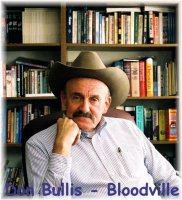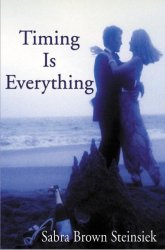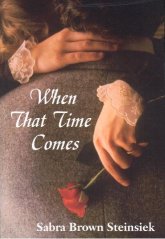New Mexico is known for its many industries; those include the arts, and arts include literature and the writing of books. There was an article in the last issue, September, about the 2002 Southwest Writers Conference in Albuquerque — a conference for accomplished and aspiring writers of books, plays, articles and poetry.
On the Lifestyle Page of this issue is the Preface from the book, THE ROCK HOUSE RANCH, by local author Barbara Corn Patterson.
This issue’s Industry page features additional authors along with the art, trials and tribulations of writing and getting published.

Don Bullis of Rio Rancho is, among other things, a writer. He wrote NEW MEXICO’S FINEST: PEACE OFFICERS KILLED IN THE LINE OF DUTY, published by the New Mexico Department of Public Safety in 1990. It details the circumstances surrounding the on-duty deaths of 160 New Mexico peace officers. It’s third edition was published in 1999. He published THE OLD WEST TRIVIA BOOK, which details many unknown facts about the American West, in 1993, with a second printing in 1998. He writes a weekly newspaper column on history of New Mexico and the southwest. He recently published a novel, BLOODVILLE, that reveals inside machinations of the case and investigations of the still unsolved 1960s murder of Bud Rice.
Following is a review — written by William Kuehl, a former State Police captain, retired municipal police administrator and director of state and international law enforcement agencies including (currently) the International Law Enforcement Academy at Roswell — of Bullis’ latest book.
“What Don Bullis has done with this novel is intertwine a very accurate weave of murder, police and politics in New Mexico. Don is the single most knowledgeable writer on New Mexico law enforcement history, practices and personalities. He should be — he’s worked for many years in New Mexico state and local policing. BLOODVILLE has the steel on steel ring of unflinching truth told in style and setting which makes this book difficult to lay aside for silliness such as meals and work. Outstandingly entertaining, thoroughly accurate and sobering as well — I recommend BLOODVILLE to folks both inside and outside policing.”
Don Bullis retired in 2002 after a career in New Mexico law enforcement that included county sheriff’s deputy, detective sergeant, town marshal, state organized crime commissioner, and criminal intelligence operational supervisor. He was a small-town newspaper editor before he entered law enforcement. To order a copy of his book — $14.95 plus shipping and handling — send an Email to don.bullis@att.net Website for Don Bullis is: http://www.donbullis.com/
Don Bullis will be in Roswell signing copies of his book, BLOODVILLE, at Hastings on Saturday, November 23 between 3 p.m. and 6 p.m.
CAPTAIN JOSEPH C. LEA: From Confederate Guerrilla to New Mexico Patriarch , by local author, Elvis E. Fleming. Yucca Tree Press, publisher. Bullis’ review was written in cooperation with the Historical Society for Southeast New Mexico.
Joseph Callaway Lea — known throughout most of his adult life as Captain J.C. Lea — was one of the most significant men involved in the economic and agricultural development of southeastern New Mexico in general, and the city of Roswell in particular. When Lea arrived at Roswell in the late 1870s, the town amounted to a small cluster of adobe buildings. When he died in 1904, it was a city of several thousand. Captain Lea was mayor.
J.C. Lea was born to Dr. Pleasant John Graves Lea and Nancy Callaway Lea in Tennessee in 1841. The family moved west to Missouri in 1849. J.C. was therefore in the right place at the right age to participate in the Civil War. Yankees — it is uncertain whom exactly — killed Dr. Lea in 1862. It is not clear whether he was killed because his sons, J.C. and Frank, rode with the Confederate guerrilla band led by William Clarke Quantrill or if the Lea boys joined Quantrill because the Yankees had killed their father. There is little doubt, however, that J.C. and Frank did ride with Quantrill, at least for a while. J.C. probably participated in the famed raid on Lawrence, Kansas in August 1863.
When the war ended, Capt. Lea “…took off his side arms, and was never again known to wear a gun.” He was not loath, however, to threaten the use of a firearm.
Not long after Lea arrived in Roswell, a crew of cowboys rode up to his store and commenced to hooraw the place, firing pistols into the air and riding horses onto the store’s porch. Lea stepped out to face his tormentors with a rifle in his hands. He ordered them to stop, and said they were welcome as long as they behaved themselves. If not, they were to leave and not return. Two additional rifles protruded from the store’s windows. The cowboys chose discretion as the better part of valor and left. The offensive behavior was not repeated.
Captain Lea came to be called the “Father of Roswell,” but that was only one of his many accomplishments. He developed the Lea Cattle Co. into the largest ranch operation in New Mexico by 1890. (John Chisum died in 1884 and his huge ranch, which had been headquartered near Roswell, fell apart thereafter.) Lea participated in the development of a system of irrigation canals in and around Roswell. He worked tirelessly for the development of the Goss Military Institute, which later became the New Mexico Military Institute (NMMI). He worked hard to bring the railroad to Roswell, and he was a leader in the efforts that created Chaves and Eddy counties. he died at the relatively young age of 63. His funeral was the largest in the history of Roswell.
This biography of Lea is long overdue. Anyone interested in the development of New Mexico during the Territorial period must have a working knowledge of the role played by Capt. Lea. He did not die rich, but left his mark in many, many other ways. Elvis Fleming of Roswell had done an outstanding job of bringing Capt. Lea to life.
Fleming is Professor of History, Emeritus, at Eastern New Mexico University, Roswell. He serves as board member and archivist for the Historical Society for Southeast New Mexico. He has written eight books on the history of West Texas and Southeast New Mexico.
Joseph C. Lea: From Confederate Guerrilla to New Mexico Patriarch, the book by Elvis E. Fleming, is available at the Historical Society for Southeast New Mexico, 200 N. Lea Avenue, and also at Cobean’s Stationery, 320 N. Richardson Avenue, Roswell. The book sells for $25, with over 260 pages plus 66 illustrations. It was published by Yucca Tree Press in Las Cruces, in cooperation with, and to benefit, the HSSNM.
The author, Fleming, is city historian, member of and archivist for Historical Society for New Mexico, as well as Eastern New Mexico University-Roswell professor of history, emeritus.
Rwm
====================================
(Following is a talk given at a writers’ workshop in Roswell on October 27. Sabra takes you over the rocky road of trying to get your book published — conventionally at first and then doing it yourself as she did.
The Roswell Web Magazine editor knows authors of books (good books!), which were sold to/published by publishing houses, who received very little for their efforts. The author of one book said — after delays and her New York editor hassling her about southwest details in her book she knew and he did not — she received no more than $500 total from the publisher. Also, nowadays it is common for conventional publishers to require authors to market their own books.
After time and money spent trying to sell her book to a conventional publisher, Sabra self-published two romance novels and is in process of self-publishing a third. The Roswell Web Magazine editor has bought and read her first book and found it to be well written, and as well and as professionally produced as any other on the market. If you like Nora Roberts books, you will like Sabra Brown Steinsiek books.)
Sabra Brown Steinsiek is a Carlsbad native and author of TIMING IS EVERYTHING and WHEN THAT TIME COMES, the first two books of her Taylor Morgan Trilogy. When not writing, she works as Head of the Serials Department at the University of New Mexico School of Law Library. She can be reached at wordsmythe@hotmail.com or through her website http://sabras.homestead.com/

I’m a self-published author.
The road to publishing is a rough and expensive one. First, you have to find an agent who believes in your book and offers to represent you. (If the agent asks for money – RUN! His/her money should come out of selling your book.) This requires sending out numerous letters with self-addressed stamped envelopes for replies (double postage!). If the agent is interested, you send a copy of the first chapters (more postage and paper and printing) then, a copy of the full manuscript (mega-postage!). The costs add up. I estimate that my search for an agent (including a money-grabber do-nothing) cost me more than $500 in a year, money out of my family budget that I really couldn’t afford. I finally reached a point that spending all of this seemed pointless and I was prepared to tuck my manuscript away and forget my dream.
Then I saw an ad for Publish On Demand (POD). And that, quite literally, is what they do. The technology is such now that they can run text and cover for a 400-page book in about five minutes. It’s done with what is basically a glorified photocopier.
The ad I saw was with iUniverse.com. I checked it out and was pleased with what I saw. Six months later, I was a published author with book in hand. What a rush that was! When the book manager at Hastings Superstore in Albuquerque handed me the first copy, I burst into tears and fell into his arms sobbing with joy. Luckily, he happened to be my husband.
Then the real work began.
THE GOOD We’ll start with the good things about self-publishing.
The first is instant gratification. For those of us without patience, bypassing all the work of finding an agent and a publisher is definitely a good thing. A book published through the traditional channels can take a year or more to be finally published. My publisher produced a quality trade paperback in six months. By the time I submitted my second book, they’d cut the publishing time to one month and still retained the quality. Their shipping time is roughly two weeks.
The second is control. I had complete control of my books. I chose the covers (although most publish-on-demand companies offer a design service) and wrote the back cover copy. No swooning maidens and muscular guys for me. They have their place but not on my books!
The third is price. You’ve all heard the stories of people who sink their life savings into publishing a book that (mega-copies) then languished in their garage. POD offers a reasonable price and you control the quantity of books you want on hand. In my case, the cost to publish was $99.00. That was it. They set up my book and keep it in their computer. It can be ordered from the publisher (in my case, iUniverse.com) or amazon.com, bn.com or other online bookstores. Local bookstores can order it from their source, usually Ingram. I receive a royalty on copies sold this way, paid by my publisher on a quarterly basis.
I keep copies on hand and work with bookstores (see more about bookstores below) to sell my books on consignment. I also sell them through my website. As the author, I get a healthy discount when I buy the books for resale. I don’t receive any royalty on these.
The publisher prices the book. On both of mine, I’ve felt the price was a little high and, when I sell them myself, I discount the price so that I’m comfortable with it. This cuts into my profits but I’d rather do that than gouge my readers.
The fourth is longevity. My books will never go out of print as long as IUniverse is in business. Most standard paperbacks are on the shelf a few months, then they’re gone — usually forever. My book will remain available for as long as I want to play this crazy game.
The fifth is promotion (you’ll find this below in the Bad section, too.) I like doing signings. I like the one-on-one with a reader. And I enjoy the challenge of creating new and exciting promotional material.
THE BAD I’d like to say self-publishing is all sunshine and roses. It can be, but it takes a lot of work and time and effort and creativity and stubbornness.
The first bad thing is getting it into the bookstores. There are not a lot of the large chains that will work with a self-published author. Most of those that do, require a 60/40 split and that leaves the author with a tiny profit. Most of my book signings are with Hastings. They are open to working with self-published authors for which I am eternally grateful, and Barnes and Noble has recently begun to accept us.
The second bad thing is promotion. It takes a lot of time and energy to promote your book. A website is a must these days. It can be an expensive proposition if you have someone design it for you. I designed my own but pay a yearly fee to keep it. And a website that isn’t updated regularly is usually an eyesore so I try to go into mine at least once a month and fiddle around.
There are many companies that offer promotional products for your book. (I recommend http://www.earthlycharms.com/) They range from notepads to mouse-pads, t-shirts and tote bags. Essential, in my opinion, is a bookmark. I print my own on the computer and cut them apart myself. Usually 200 or so per signing since I try to hand one to everyone who comes near my table. I’ve tried other things, such as luminarias for Christmas. That didn’t work. I have chocolates wrapped in my book-covers (also produced on my computer) which are a great hit. Door prizes are a good idea at signings and I offer a monthly contest on my website. This all adds up to money — so maybe the agent thing isn’t so bad.
The truth is that, unless you’re Nora Roberts or Michael McGarrity, you’re not going to get much help from the publisher (not even when one buys your book). A classier poster, shinier bookmarks, but those signings are still the same. They’re fun but they’re work and they’re exhausting.
THE UGLY I hate this part so I’ll keep it short.
Being self-published requires great self-confidence and a thick skin. Many national writing organizations do not consider a self-published author as “published.” I recently entered a contest sponsored by a chapter of Romance Writers of America. I had to enter in the unpublished category because I am not traditionally published. I have two books on shelves, but I am “unpublished.” Unfortunately, many times “self-published” seems to equal “unclean.” The truth is, if you can get published in the mainstream, it’s better. It has more clout, more respect. It’s easier on you. But it does not make a mainstream published book “better” than yours. Don’t let them convince you of that. If you choose an alternate way, you are still ending up with a published book. As an author and a librarian, I believe the point is to get my book in print and on the shelf. Let the readers make up their minds as to the merits of my self-published book against the traditionally published book. Published is published.
WOULD I DO IT AGAIN? I would and I have. I published the sequel to Timing is Everything with iUniverse. Since it’s a trilogy, I’ll probably publish the third book with them as well so they’re together with the same publisher.
I’m at work on a manuscript that isn’t part of my trilogy. (It’s another romance.) For this one, I think I’m going to “shop around.” I think I’ll skip the agent; I’ll try the editors this time. But I only give them six months. After that, it’s back to iUniverse.
There are a number of POD publishers out there. Do a search on the web. I’ve heard good and bad about all of them. Look at their prices and their products. Some are beginning to do children’s books. Some are beginning to offer hardback copies. Study what’s out there. Ask a self-published author. Join a writers’ group — there’s one in Roswell, probably others in Carlsbad and the southeast area of the state. Online, try http://www.earthlycharmspromo@yahoogroups.com/ They’re a good mix of all genres and all publishing types. Ask around and you’ll find the answers.
Above all, follow your heart and your dreams. It’s hard work but you’ll never regret it.

 Roswell Web Magazine
Roswell Web Magazine